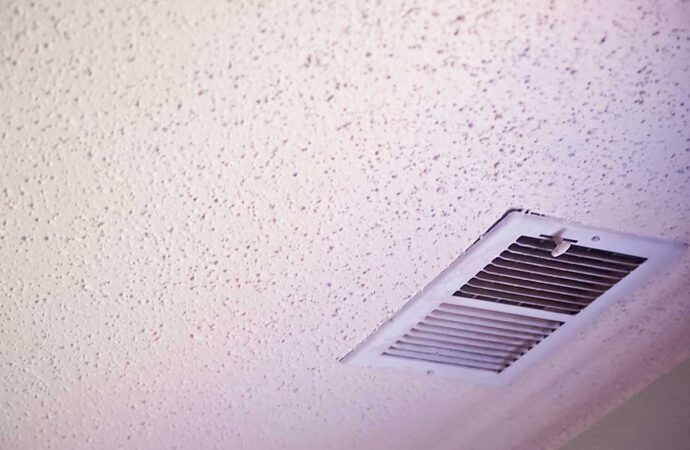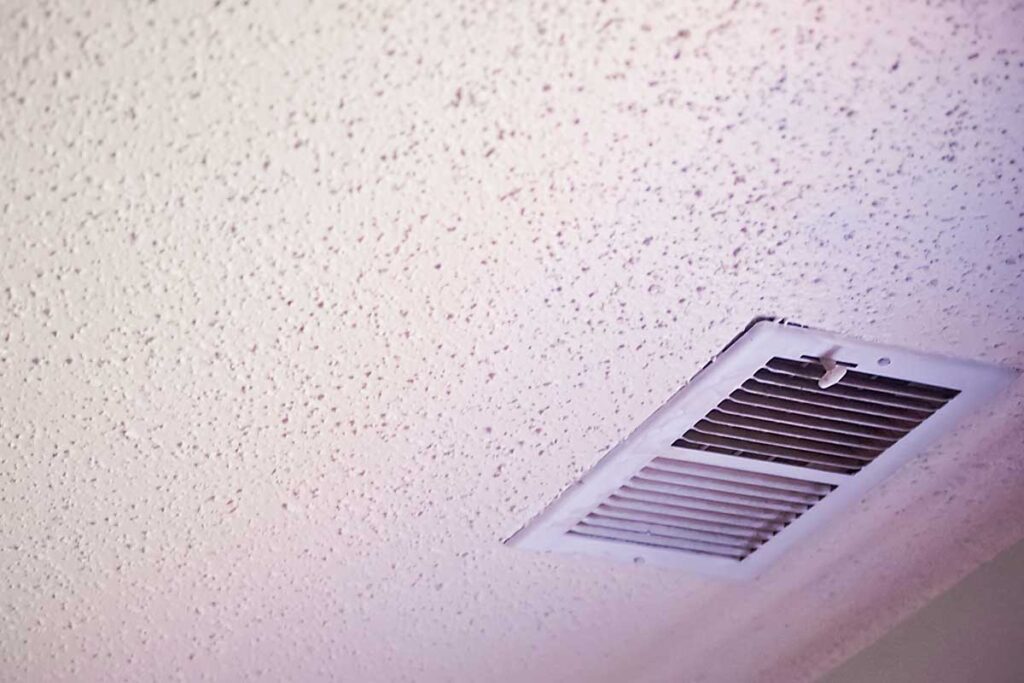Ceiling paint best for textured ceilings can improve the appearance of your home’s most significant open area. It will brighten your largest surface and seal the drywall texture. The type of ceiling texture will dictate which ceiling paint you should use. We’ll be covering most surface types, and any ceiling paints that can be used on them—deciding if new textured ceilings are necessary and which paint options are best. Painting ceilings is not an easy task. This process will be smoother if you get it right from the beginning. What ceilings should you choose? This is a common question that we will answer. For uniform paint sheen, most orange peel ceilings are flat and non-reflective. While it is possible to paint a small ceiling area, this can be done several times. However, you will need to paint the entire ceiling more often. The best results will be achieved if you know which direction to paint ceilings. You will need to know which direction you should paint your ceilings. Below are the most famous ceiling colors for the tallest sections of your home. Paint is required for every textured ceiling, even those that are perfectly smooth. There are many reasons that ceilings of any texture need to be painted. The first is that drywall texture uses a soft topping material. It isn’t easy to clean and wipe down because it is so soft. The surface you have painstakingly created will be damaged if rubbed with a damp rag. Second, drywall texture attracts dust and can give off dust if it isn’t correctly painted. You’ll need to dust off the drywall ceiling texture with a dry cloth before painting it. Textured ceilings are not painted. Priming a new ceiling texture will allow the human eye to detect imperfections or smoothen the finish before applying the final coat. It is vital to prime ceiling texture before painting, even if it is level 5. If you cannot see anything after priming, you will likely see them after you paint unless you fix them. Primer is the perfect medium to identify them visually. Once you have textured the ceiling and gotten it swept down, it is time to paint. For any new ceiling texture, a flat primer of polyvinyl acetate (PVA) is required. Ceiling textures usually only need one primer coat. You are simply trying to seal the texture and make applying the final paint coat easier. This is why you should prime ceiling textures first. Let the PVA dry for 12-24 hours before using your final paint coat. Here are a few things to remember before you dive into the best paint for textured ceilings A matte PVA primer is required before you can apply a new ceiling texture. It should be brushed, rolled, and sprayed first. No matter the texture, the best ceiling paint leaves no lines, marks, or lap marks. You can’t paint more than one square if you haven’t painted the ceiling surface for more than a year. You’d be best to paint the entire ceiling surface from corner to corner, from each side. You will see flashing everywhere, regardless of what ceiling texture you may have. Ceiling flat white will have the lowest amount of reflections on large areas in your home, particularly ceilings. Ceiling paint finishes are available from most major brands. It would be shelf-boxed if it had any other sheen. It would be impossible to pull the shelf off. They would make it up specifically for you. You could choose from satin or ceiling white eggshells. Flat ceiling paint is best. Flat paint finishes are less reflective and do not draw attention to the surface. Flat ceilings can be used depending on the look you want. Satin paint finishes will reflect a little, but it is possible to paint walls and ceilings with the same paint and finish as satin. Satin can be used if you have any texture, such as orange peel, knockdown, skip trowel, or popcorn on ceilings. However, a flat paint finish will look better. Flat paint is best for smooth ceilings above level 5. Ceiling surfaces usually only require one coat of PVA primer. An excellent interior paint will dry in one coat. However, we recommend two coats for ceilings. Less expensive ceiling paints may be more expensive, but it requires twice as much work to apply two coats. Even though it may cost a few dollars less per gallon, it does not always make sense. The best premium ceiling paint is from a variety of named paint companies. These paints only need one coat, while others have primers. Paint & Primer with built-in primer does not mean you should not prime drywall using a PVA primer first. A PVA primer is recommended first because any ceiling texture imperfections can be easily seen and corrected before the final paint coat. This is it. Apply one coat of PVA primer to the new ceiling texture. Followed by one or more finish coats. Between each application, allow for proper drying. Ceilings with a wide variety of textures tend to be painted white. Pre-mixed ceiling paint colors are available at most paint stores. Most ceiling whites are available in flat paint finishes, but you can also get custom ceiling whites in any sheen. You cannot return custom ceiling whites that you have purchased in excess. You can still use pre-packaged paints if they are not opened. Flat ceiling whites are the most popular, as they don’t reflect or give off any glare in high-traffic areas of your room. This is a continuation of the topic. Any custom paint color that a paint store must mix, you can add the colorant. Contractors love to use a store’s ceiling white. Unopened containers can be returned. Many major paint companies offer their mix of white ceiling paint. Most shelf ceiling paint comes in a flat finish. These paints can be applied evenly and bond to a primer to seal the ceiling. It doesn’t take a high-end designer painter to paint ceilings. The only one that can adequately lay down and seal. Major paint companies like Boynton Beach Popcorn Ceiling Removal & Drywall Contractors have a shelf or boxed white ceiling paint. A high-quality brush and a wide-spread roller are essential for painting textured ceilings. A minimum of a 1/2 inch roller skin or nap should be used on your roller. A roller skin that is half an inch thick will allow you to roll out more paint without having to dunk the roller again. You will need first to cut out corners and light fixtures when painting an orange peel, knockdown, swirl, or Santa Fe skip-trail texture. Once you have finished cutting all areas, roll the ceiling. You can roll out the ceiling and pick one quadrant. Then, you can make a W. This will allow you to paint enough paint in a given area without dripping. This method allows for a better paint application for most textures. It is not recommended to paint walls with ceiling paint or vice-versa. Ceiling paints have lower viscosity and hardness than wall paints. Although ceiling paints are cheaper, they will not protect walls as well as wall paints. It will be easier to know which direction to paint a ceiling. Let’s suppose you have a vaulted ceiling. Begin painting the ceiling at the lowest point and work your way up. Ceilings are generally flat. You can choose to work from one side or the other. Keep your roller in the same place. It would help if you did not flip it over after you have submerged it in paint. The Roller frame should be kept in the same position. Doing this could leave lap and roller marks. There will be a lot of movement up, so take your time. It would help if you painted the ceiling in the same direction as possible. You’ll get it done. You’ll get the job done if you take enough breaks. To properly seal your ceiling texture, remember to prime it before you paint the last coat. Use a PVA primer specifically designed for the final coat of your ceiling. Ceiling painting can be difficult and time-consuming. First, install flush light fixtures, outlets, and hooks to your ceiling. After cutting, spray or roll the ceiling. Start in one quadrant and work in the same direction before moving to another. Ceiling paints can be used for most ceiling textures, if not all. Most packaged ceiling paint comes in a flat finish. It is suitable for use in all home rooms with low moisture content. Ceiling paint is significantly cheaper than other types of paint, but it does not have the same quality. Because it won’t take nearly as much traffic as your walls, ceiling paint is not recommended for use. This should help you paint your next textured ceiling. We would love to hear from you. Are you a Colorado resident and need a professional to paint your ceiling texture? Eco Paint, Inc. has years of experience painting ceilings like yours. The drywall compound, also known as mud, can be applied to ceilings in many different patterns. These patterns can add personality and interest to your space and break up the monotony of a flat ceiling. Textures conceal imperfections, stains, and areas that have been repaired. Each texture is given a name such as slap, knockdown, and swirl. Each texture can be created using simple tools that you may already have at home. The drywall compound, also known as mud, can be applied to ceilings in many different patterns. These patterns can add personality and interest to your space and break up the monotony of a flat ceiling. Textures conceal imperfections, stains, and areas that have been repaired. Each texture is given a name such as slap, knockdown, and swirl. Each texture can be created using simple tools that you may already have at home. We offer the above services at the following locations within Boynton Beach:
If you are located in Palm Beach County and you don’t see your city/area listed above, don’t worry! We cover all of Palm Beach County. Fill out the contact form above or CLICK HERE and send us a message. We’ll get back to you asap!
Orange Peel Ceiling
Contact Us

Are You Looking To Paint New Textured Ceilings
Best Paint Finish for Ceilings
What is the best paint for ceilings? Satin or flat?
How many coats of paint do you need to paint ceilings?
Which Ceiling Paint Color is Best?
Best Paints for Textured Ceilings
How to Paint a Textured Ceiling
Types of Ceiling Textures
Which direction should I paint a ceiling?
Locations We Serve

